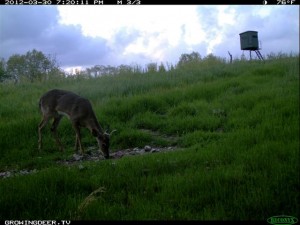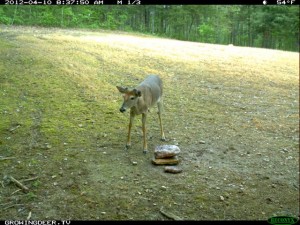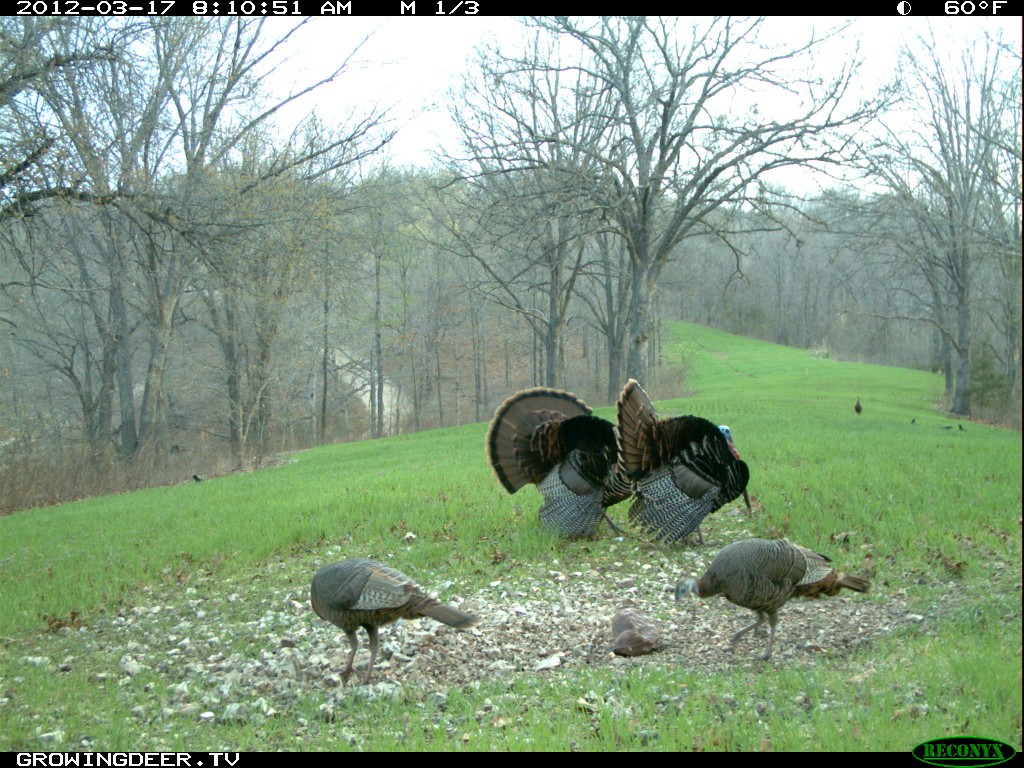Category: Trail Cameras
The Deer Hunter’s Second Season: Shed Hunting
There are a few more days of archery season in Missouri and a few other states. Grant and the boys still have a few days to fill their tags here at The Proving Grounds. Once archery season ends, Grant will give me permission to start my season – shed hunting! Late winter is the time that I enjoy most here in Missouri. The woods are free of ticks and snakes. The brush has died back so that the hills and glades are easier walking. Best of all – Crystal and I can find special treasures while walking these Ozark Mountains – shed antlers! (Crystal is a Labrador Retriever that I have trained to find and retrieve shed antlers.)
Shed hunting in the Ozarks is not like shed hunting in the states that have flat land like Iowa, Kansas, or Illinois. I envy the folks that can go shed hunting and spot one 300 yards away! Finding a shed in these hills is akin to an Easter egg hunt where the eggs are well hidden. When you find a shed you consider it a special blessing!
My first objective will be to initially walk the valleys in search of deer that may have died during the fall from EHD. Our valley contains a creek that although it isn’t a perennial, flowing source of water, it does have certain deeper holes that held water even through this last summer’s drought. Those are the targets for my initial hunts. Crystal and I will be looking, but not necessarily hoping, to find the bucks that were lost due to the disease. Our fear is that we will find many more like the one Grant recently found pictured below and the one shown in the GrowingDeer.tv video back in September (GDTV 147).
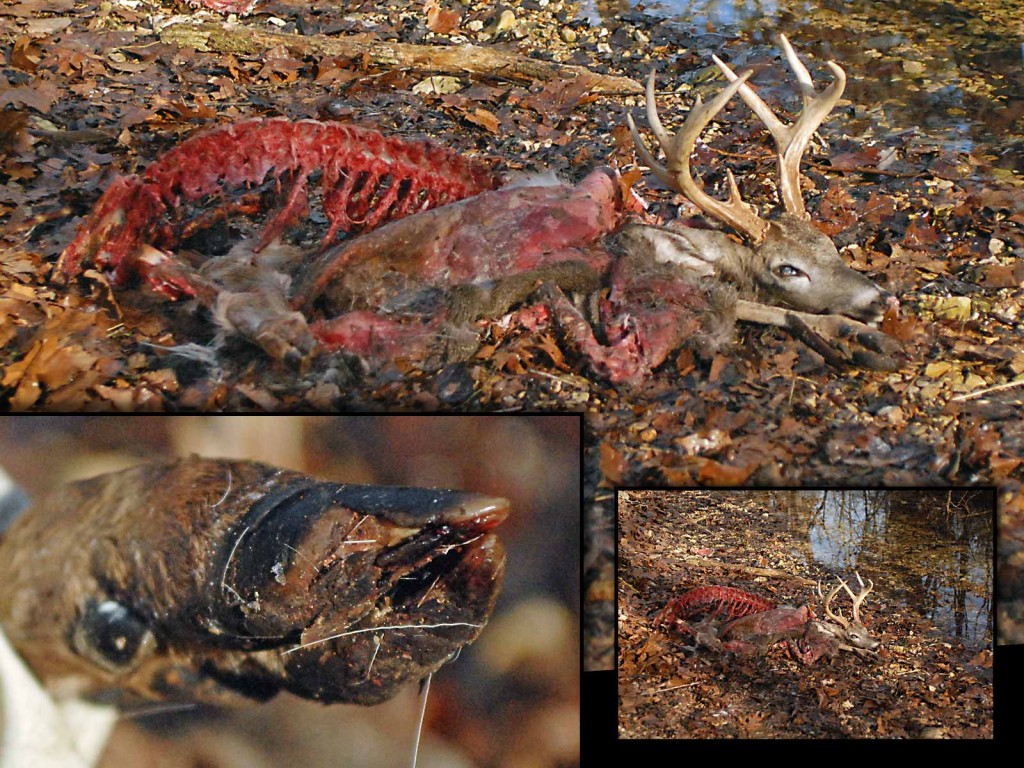
Initially I will walk the valleys in search of deer that may have died during the fall from EHD, like the buck pictured above.
On the brighter side, hunting in the valley has an additional benefit – it is relatively flat which will be the beginning of conditioning for both Crystal and me for the harder exercise of searching the hills!
Once the water sources have been hunted I will move on to the rest of the property. Grant and the boys will still be using the Reconyx cameras to monitor the deer herd to determine which bucks made it through the season. As soon as bucks start to show they are loosing antlers, I will develop specific areas to canvas based on the travel patterns shown by the Reconyx MapView software. Perhaps we’ll get lucky like we did last year (see it here in GDTV 116) and the Reconyx will capture images of one of our hit list bucks the night that he sheds his antlers!
Grant and I will be sharing some other tactics to help you find shed antlers in future blog posts. In the meantime – get out there to get some exercise and enjoy Creation! Enjoy the shed hunting season and share when and what you find on our Facebook page! I look forward to hearing about and seeing all the great treasures you find in the next few weeks.
Enjoying Deer together,
Tracy Woods
Why Bucks Are Shedding Antlers Early
Throughout the whitetails range I am receiving reports and photos of bucks that are already shedding their antlers. Since early December 2012 I’ve gotten several Reconyx trail camera pictures of bucks that have already shed one or both antlers here at The Proving Grounds. It’s common for an occasional buck to shed early due to injury. However, I suspect about 10%+ of the bucks at my place have already shed.
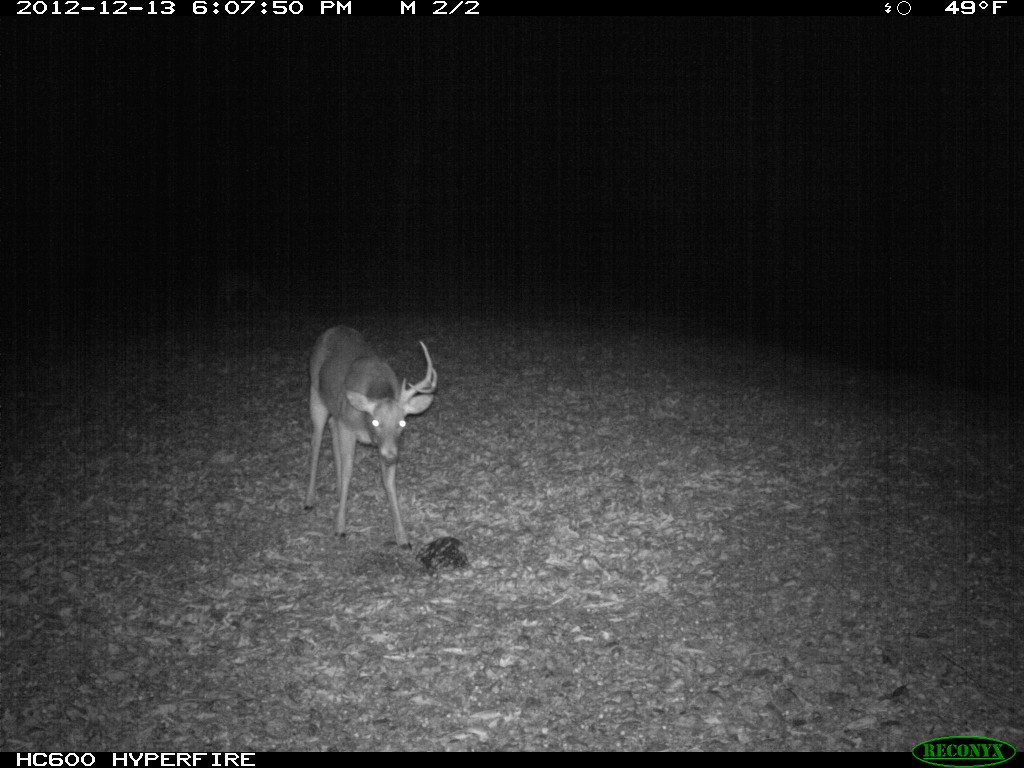
Since early December 2012 I’ve gotten several Reconyx pictures of bucks that have already shed one or both antlers.
Early shedding is a sign of stress. I’m sure deer at my place are stressed. During the 2011 growing season we experienced an extended drought followed by a record drought (the driest July during 118 years of record keeping) during 2012. Plants can’t transfer nutrients without water. Therefore forage quality was most likely severely decreased during the past two years.
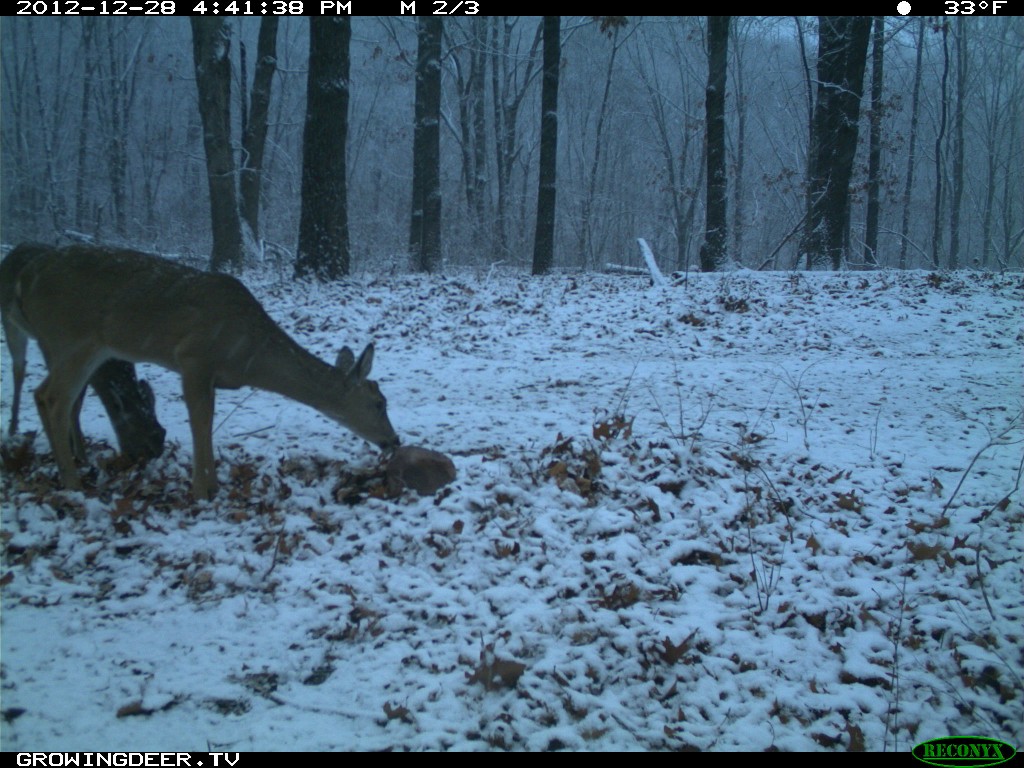
During the past two years the deer at my place experienced extended drought and a major outbreak of EHD.
There was also a major outbreak of EHD at my place (as in many places from Florida to Wyoming) last fall. There are two forms of EHD, acute and chronic. Deer with the acute form of EHD usually die within 24 to 36 hours. Deer with the chronic form may or may not die. If they do die, it often takes months.
We’ve found bucks that probably died from both forms of EHD (GDTV 147). The good news is that Mrs. Tracy will likely find a lot of sheds this year! The bad news is that she will also find a lot of skulls of bucks that died before they shed their antlers. I’ll keep you posted as Tracy and Crystal begin shed hunting. They will start just as soon as the archery season closes in Missouri (January 15, 2012).
I’ll begin a supplemental feeding program using the high quality feeds from Record Rack. I’ve never used supplemental feed before at The Proving Grounds. However, given the drought and amount of stress the herd is experiencing at my place, I think supplemental feeding is a very smart management strategy. I’ll keep you posted on our feeding program through this blog, on my Facebook page, and on GrowingDeer.tv!
If you’ve never used supplemental feed before, stay tuned and I’ll show you how and why I opted to use this strategy from a biologist’s point of view.
Growing Deer together,
Grant Woods, Ph.D.
Wildlife Biologist
Are You Seeing Antlers?
“Are you seeing antlers?” This time of year that question almost always means seeing bucks that have started growing a new set of antlers. However, that’s not the case this year. Due to the record warm winter and significantly lower than normal stress levels on deer, many bucks throughout the whitetails’ range are still holding antlers from the 2011-12 season.
At The Proving Grounds we got Reconyx images last week of bucks still holding antlers from last season and bucks that have shed and are starting to grow new antlers. I’ve even had a report of an image from Iowa of a buck that still has his antlers from last year and is starting to grow new antlers off to the side. That has happened before – but it is very odd.
I don’t know (and I doubt anyone does) what all this means as far as antler growth this summer. I strongly suspect the growing conditions this summer will be more of an influence on antler production more than the odd shedding pattern that is occurring. I’m very eager to see how antlers develop this summer! I would appreciate seeing trail camera images of bucks that haven’t shed as of today (April 13th). I’d also really appreciate any trail camera images of bucks that are growing their new antlers while still holding antlers from last year. (You can upload the images directly to my Facebook page.)
Odd years produce odd results. I’m eager to see how the average antler production during 2012 turns out!
Growing Deer (and learning) together,
Grant
Youth Turkey Season
Youth turkey season begins tomorrow in my home state of Missouri! I plan on taking my oldest daughter, Raleigh – 13, tomorrow morning and my younger daughter, Rae – 10, tomorrow afternoon. It’s legal to hunt turkeys from sunrise until sunset in Missouri during youth season, and only until 1pm during the regular season (starting in two weeks).
I’ve been using my Reconyx cameras in an effort to pattern turkeys. I’ve placed the cameras overlooking food plots that I know from past experience are areas where gobblers like to strut.
Using this technique, I have located two plots that turkeys are frequenting somewhat regularly. I enjoy cut and run turkey hunting, but not for taking my daughters, especially Rae. Patterning turkeys and using a ground blind is an outstanding technique and allows much more father/daughter time and conversations!
I think I’ve crossed another hurdle this year. Last year, a large gobbler hung up on Rae and I about 150 yards out (GDTV 73). That turkey stayed on the ridge for more than an hour! That’s a long time for any hunter to hold a shotgun – but close to impossible for a 9 year old. This isn’t as large of a feat if the hunter is sitting on the ground with his back to a tree. He can rest the gun on his knee and find a time to move it slightly as the tom approaches.
However, taking a gun from leaning in the corner of a blind to sticking out the window (about 2”) for a 9 year old can be tricky – especially after watching a strutter for more than an hour! This year I have a Caldwell DeadShot FieldPod. Simply stated, it’s a very light, tri-pod (stable) that holds both the front and back of the shotgun. I actually got if for me for long range predator hunting, but tried it yesterday with Rae’s 20 gauge and decided it was perfect for a youth hunt in a turkey blind.
I’ll share the results of using the Reconyx to pattern gobblers and hopefully how Raleigh and Rae liked the DeadShot FieldPod next week.
No matter what happens, I’m sure the time in the blind will be a trophy for my book!
Growing Deer (and children) together,
Grant
Bucks Shedding Antlers Early
Adam called me two days ago with a bitter sweet message. He had found a shed from Giant 8. It was bitter because I had used some Reconyx cameras to understand Giant 8’s post late season feeding pattern. I had a Muddy hung, and felt I could tag him when the temperatures dropped and he needed to feed more during the daylight to gain calories to maintain his body weight. That plan is now canceled.
The sweet part is that his shed was found in one of two food plots that I had determined where Giant 8 was feeding. My scouting was spot-on! In addition, I’d rather the shed be found and confirmed it was a clean shed (no sign of injury, brain abscess, etc.) than he simply disappear.
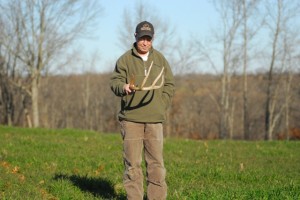
- Grant holding shed from Giant 8
I host an annual shed hunt during March. Even though March is relatively late for many shed hunters, we always jump a buck or two that still has antlers. However, I have multiple images of bucks that have shed early this year. In addition, folks from throughout the whitetail’s range have commented on my Facebook page about bucks shedding early in their neighborhood.
I expected bucks to shed earlier than normal this year – but not this early. Bucks will shed early when they are stressed. It was the fourth driest summer on record where I live. In addition to the lack of moisture, several months were recorded as the hottest or some of the hottest on record. Those hot and dry conditions caused a huge amount of stress to Eagle Seed beans planted in my plots. I was shocked they grew as well as they did – my other crops perished.
To a deer manager, forage plants are simply nutrient transfer agents. They simply transfer nutrients from the soil and air to the consumer (deer). No matter how many nutrients are available, plants can’t transfer nutrients without water. Soil moisture was so limited this year that the plants simply couldn’t transfer many nutrients. The heat directly and indirectly caused a huge amount of stress to bucks in my area this year.
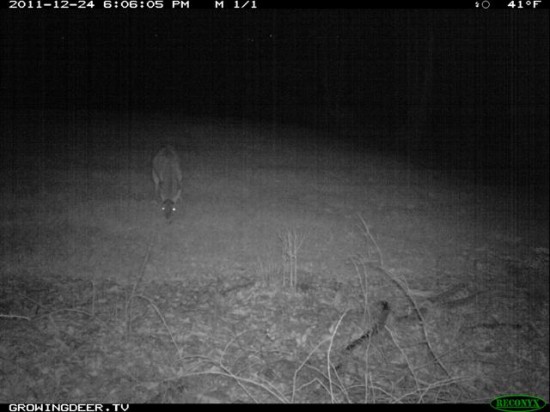
Giant 8 after he shed his antlers
I was shocked that the antler production was as good as it was during 2011. This was confirmed by comparing some sheds we found last year to some mature bucks that were harvested here this year (most notably Giant 10). I was pleasantly surprised that they actually produced larger antlers than during the previous year when the growing conditions were much better! This is a great testimony of the relationship between age and antler development. If you wish to harvest bucks with larger antlers, allow the bucks where you hunt to mature and provide the best nutrition you can afford. Food plots are relatively easy to produce and can definitely yield great results in allowing bucks to be healthier (larger antlers) and easier to hunt.
However, a buck’s antler growth potential (genetic potential) can only be expressed if the buck is allowed to live until it reaches older age classes AND has access to quality nutrition year round. It seems my buck hunting may be over soon even though the legal season where I live extends to January 15th. I learned some very valuable lessons about managing for and hunting mature bucks during the drought of 2011. I’ll be a better manager during 2012. I will continue sharing what I learned in this blog and each week in the video episodes of http://www.GrowingDeer.tv. Thank you for being part of the http://www.GrowingDeer.tv team and for sharing what you’ve learned and observed with us. May you be blessed with a great 2012.
Growing Deer together,
Grant
Patterning A Mature Buck
I grew up rabbit hunting. It was the game of choice as there wasn’t a deer season in the county where I was raised. One of my favorite pastimes was tracking or back tracking rabbits in the snow. I probably learned more about rabbits and rabbit hunting by back tracking rabbits in the snow than I did from anything else with the exception of invaluable lessons from my grandfather and father (they were incredible rabbit hunters). In hindsight, those lessons were of huge value to me as a deer biologist and hunter. I learned that critters need food, cover, and water and will use the path of least resistance to move from one to another AS LONG AS THEY DON’T FEEL THREATENED ALONG THOSE PATHS.
The same is true for mature bucks. They need food, cover, and water on a regular basis and will move between these resources along the path of least resistance as long as they don’t feel threatened. One of my hunting tactics is to determine if there are mature bucks in the area by using Reconyx cameras and then use aerial photos to locate the likely sources of food, cover, and water close to the camera that photographed the buck. Notice that I didn’t say I moved the camera to monitor the sources of food, cover, and water. One of my keys to success is being very aware of the bold words in the previous paragraph – AS LONG AS THEY DON’T FEEL THREATENED ALONG THOSE PATHS.
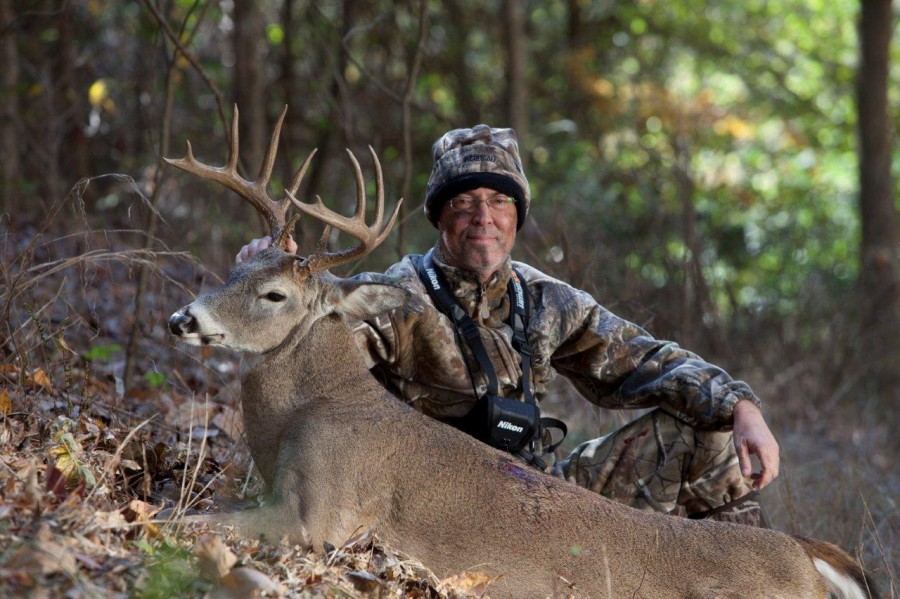
Most of my neighbors hunt and deer are constantly being alerted during the season in my neighborhood. I know deer will range off my property. However, I want to encourage them to spend as much time on my property during daylight hours as possible. That’s one reason why I created sanctuaries! Deer, even during the rut, will likely spend most of the day resting in thick cover. If I can protect bucks during the day, they will have a good chance of surviving to maturity. In addition, if mature bucks are conditioned to finding safety in the same area (sanctuaries), then it’s easier to pattern them.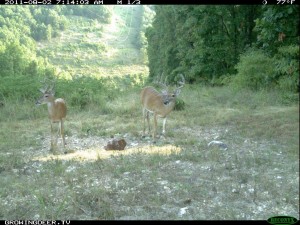
I used this strategy last Friday to kill a buck I had named Clean 12. It was a great hunt as I watched the buck for more than 10 minutes including watching him make a scrape, thrash some limbs with his antlers, and vocalize a snort wheeze. I ended up shooting Clean 12 at three yards! It was a thrilling hunt!! However, what made this encounter with Clean 12 work was simply applying the strategy outlined above.
I had obtained several Reconyx images of Clean 12 during the late summer. I placed some Reconyx cameras in open areas such as Trophy Rock stations and food plots to get a feel for his range and travel patterns.
I knew I wouldn’t likely hunt at any of those camera stations 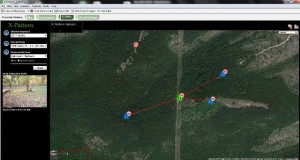 because they were in open areas. Mature bucks would rarely visit them during daylight once season opened. I then used my knowledge of the closest locations for food (used mainly at night by mature bucks this time of year), water (several springs and seeps in the area so no way to predict which source he might use), and cover.
because they were in open areas. Mature bucks would rarely visit them during daylight once season opened. I then used my knowledge of the closest locations for food (used mainly at night by mature bucks this time of year), water (several springs and seeps in the area so no way to predict which source he might use), and cover.
Years ago I had created a sanctuary at the east end of the area where I had images of Clean 12. It seemed the obvious bedding area for Clean 12 . It was the most limiting of three needs a deer has daily (food, water, and cover) in the portion of his range I had confirmed. In addition, I could approach from the east and not enter the area where I had patterned him mainly at night. A northwest, west, or southwest wind would be perfect for the area between where I knew Clean 12 was using and the sanctuary. This area is a de facto transition zone. Deer shouldn’t feel threatened moving into the sanctuary so the site I picked to hang my Muddy stands was the path of least resistance. Finally, the sanctuary was lower in elevation than the ridge where I had determined Clean 12 was using at night and the thermals would be pulling scent downhill (east) and away from where I predicted Clean 12 would be coming from toward the sanctuary.
With my plan in place, Adam (my cameraman) and I were able to approach our stands without alerting deer anywhere to the west of us. About 9 am, I spotted a buck 70 yards away moving toward the bedding area. The habitat work, placement of the Reconyx cameras, and Muddy stands had paid off. You can see the events that occurred when Clean 12 closed the last 70 yards on GDTV 101.
Growing (and hunting) Deer together,
Grant
Antler Growth
There can be no argument that man has been intrigued by antlers and antler growth since the beginning of time. Antlers were the frequent subject of paintings, carvings, etc., by prehistoric man. I’ve yet to meet the child that didn’t accept an antler from my hand when offered. They tend to study the antler, count the points, rapidly notice the unique characteristics, etc. Almost everyone that visits my home comments on the light fixtures made from antlers or the sheds that Tracy uses to decorate our house. Antlers captivate humans from all cultures.
As a scientist and hunter, antlers captivate me. I understand the basics of how antlers are formed – the annual cycle of storing and mobilizing minerals. However, for a critter to grow something the size of a man’s arm and replace it annually is truly a miracle that even science struggles to understand fully.
As a hunter that appreciates creation, the fact that every antler is unique (like a human finger print) is astounding! I just finished the trail camera survey at my property. The unique shape of each buck’s antlers allowed me to identify dozens of unique bucks (from young to old). I wait until mid August to implement trail camera surveys each year so the antlers are developed enough to allow each buck to be specifically identified.
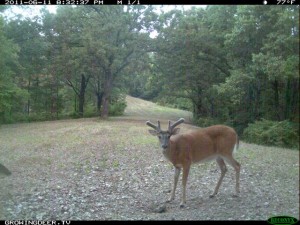 The image on the left taken during June is of a buck I call Clover Mountain Crab Claw. This buck has been present on my property for years. He is at least six years old. His rack has changed from having 8 points to 9 points and back to 8 typical points this year. I can usually accurately identify Clover Mountain Crab Claw by his body – he’s a tank! However, I wait until August to definitively confirm his identify and know that he has survived and avoided me for another year.
The image on the left taken during June is of a buck I call Clover Mountain Crab Claw. This buck has been present on my property for years. He is at least six years old. His rack has changed from having 8 points to 9 points and back to 8 typical points this year. I can usually accurately identify Clover Mountain Crab Claw by his body – he’s a tank! However, I wait until August to definitively confirm his identify and know that he has survived and avoided me for another year.
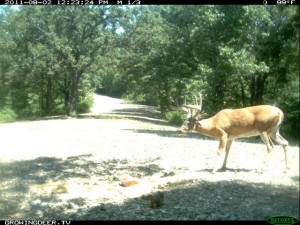 Hunting on the same property year after year allows sportsmen to learn much from the bucks whose range overlaps at least a portion of that property. It allows hunters to learn the general habits of bucks, and if they are good students, the individual movement patterns of each buck. Some bucks have a very large home range. Clover Mountain Crab Claw has a very small home range – as his picture is rarely captured at more than one camera station on my property.
Hunting on the same property year after year allows sportsmen to learn much from the bucks whose range overlaps at least a portion of that property. It allows hunters to learn the general habits of bucks, and if they are good students, the individual movement patterns of each buck. Some bucks have a very large home range. Clover Mountain Crab Claw has a very small home range – as his picture is rarely captured at more than one camera station on my property.
Watching the progress of antlers growing during the summer fascinates me. In addition, it allows me to learn the vast majority of bucks using my property. This is a huge benefit when hunting during the fall and trying to play by my own harvest guidelines. By being very familiar with the antler configuration of most of the 4+ year old bucks I can make rapid decisions of whether to shoot or not when a buck that appears mature comes in range. The thrill of being able to recognize the individual buck and know his estimated age is as fun to me as any other portion of the hunt.
Antlers are mysterious from a science and deer hunter’s point of view. They motivate us to spend gads of hours and resources attempting to learn more and obtain them. There is great value in antlers – and I believe the bulk of this value occurs before the buck is harvested. Those cave paintings have lasted and intrigued man for at least a few thousand years. So this fall when I’m spending many hours attempting to get my hands on a set of mature antlers, feel free to remind me of the joy I’ve already experienced watching one of the great mysteries of creation – watching antlers grow. If Clover Mountain Crab Claw avoids me again this year, I’ll still enjoy searching for his sheds and maintaining good quality habitat so I can see how his antlers develop next summer.
Growing (and chasing) Deer together,
Grant
Harvestable Mature Bucks
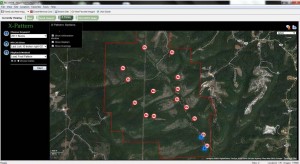
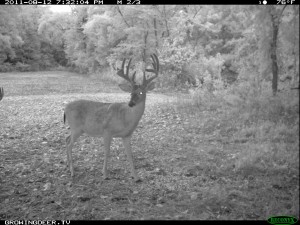 I enjoy studying mature bucks. My Reconyx trail cameras are one of the best tools available to study mature bucks. The cameras themselves don’t spook mature bucks, but there is more to the Reconyx than being a great trail camera. Each camera comes with a free software package, BuckView / MapView, that allows me to easily track the movements and see the pattern of mature bucks. The ability to track where bucks are moving on an aerial image of where I hunt is a tremendous tool.
I enjoy studying mature bucks. My Reconyx trail cameras are one of the best tools available to study mature bucks. The cameras themselves don’t spook mature bucks, but there is more to the Reconyx than being a great trail camera. Each camera comes with a free software package, BuckView / MapView, that allows me to easily track the movements and see the pattern of mature bucks. The ability to track where bucks are moving on an aerial image of where I hunt is a tremendous tool.
I dreamed of tools like this when I was in grad school. However, they were not available or simply cost too much. Now, for the price of a trail camera, I can monitor the movements of mature bucks. Technology is great!

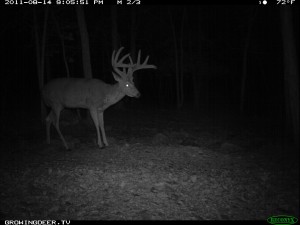 Monitoring the movement of mature bucks does not equate to harvesting a mature buck – but it sure helps. One thing it tells me is the amount of my property a mature buck is using. Some bucks will only use a small portion of a property or have a very small home range. Others mature bucks will have a larger home range or simply use more of the property. This later group includes the bucks that I will focus on while hunting.
Monitoring the movement of mature bucks does not equate to harvesting a mature buck – but it sure helps. One thing it tells me is the amount of my property a mature buck is using. Some bucks will only use a small portion of a property or have a very small home range. Others mature bucks will have a larger home range or simply use more of the property. This later group includes the bucks that I will focus on while hunting.
Bucks are like people – they have different personalities. Some of my friends were raised, got married, and have jobs in the same county where we were born. Others settled far away. As we matured, some of us travel far and wide frequently. Others feel more secure remaining close to their childhood home turf. The same is true with bucks. Each buck has an individual personality. Bucks that have a small range or only use a small portion of the property you hunt can be very difficult to kill. If a buck has a small range, he probably knows every wind current, tree, etc., very well. He can detect change/disturbance to his environment very easily.
Bucks that cover more area probably don’t know each acre nearly as well. In addition, if they are traveling more they are probably crossing more areas that are favorable to hunters (areas where the access, steady wind, etc., favor allowing hunters to select a stand location that won’t alert bucks).
For example, I’m just finishing the annual camera survey at The Proving Grounds. Two mature bucks are using one of my Trophy Rock sites, Last Lick. One of the bucks, Last Lick Right Kicker, only visited the adjoining camera site. He is currently only using a small part of the property where I hunt. I predict I won’t have many encounters with him this fall.
Another mature buck, Last Lick Big 10, is using that same Trophy Rock site and multiple others. When bucks travel relatively far during this time of year, they tend to be moving a lot during hunting season. Although Last Lick Big 10’s pattern may change once he sheds his velvet, I suspect my odds of having an encounter with him this fall are much better!
I’m currently moving my Reconyx units from the location where I do my annual deer herd survey (Trophy Rock locations) to monitoring travel corridors, feeding fields, etc. I’ll use the Reconyx software to track the patterns of these and other bucks. From past research and experience, I’m betting there’s a much better chance my taxidermist meets Last Lick Big 10 than Last Lick Right Kicker. I’ll let you know…
Growing (and hunting) Deer together,
Grant
How to Pattern Bucks With Trail Cameras
Most of us would enjoy preparing to hunt knowing that the results of our scouting gave us much confidence that a mature buck was regularly passing within range of our stand. Scouting is a skill as much, if not more, than calling, shooting, and other hunting activities. With hunting season rapidly approaching, I wished to share some of my techniques for scouting using trail cameras. A neat thing about trail cameras is that they allow us to scout for individual deer, not just deer sign in general.
For example, finding scat, tracks, and evidence of browsing is great, but they don’t tell us with confidence if they were left by a buck or doe, or how mature the deer was. They also don’t tell us the time of day the deer was present. Trail cameras allow us to scout for a specific gender and/or age class of deer.
Knowing that deer need food, cover, and water, I typically use my Reconyx cameras to monitor food as quality food is usually in limited distribution during deer season in many areas. I also monitor other areas such as travel corridors. However, I don’t place my Reconyx cameras near my stands. The camera itself doesn’t spook deer, but me installing and retuning to check the camera can condition the deer, especially mature bucks, to avoid the area during daylight hours.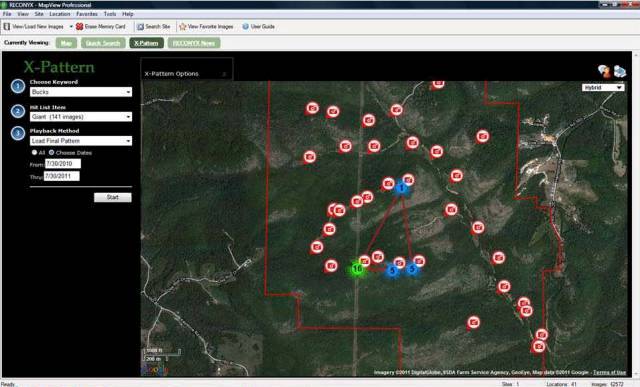
That’s why I typically monitor larger fields or feeding areas where I can approach in a truck and not walk very far to install and tend the camera. In addition, large openings are ideal for using the time lapse feature. Time lapse is simply taking an image of the opening every 15 minutes or so. This allows me to pattern deer using the field even if they are further from the camera than the detection area. Even though I might not be able to score a buck at 100+ yards in a trail camera image, I can identify him as a hit list candidate or not. This is another reason I use Reconyx units as the time lapse and auto detection systems will work simultaneously – giving me the best of both features!
The time lapse feature allows me to really limit disturbance in a possible hunting area and the detection mode gives images of outstanding image quality. Combining the advantage of scouting with a trail camera and knowing where a preferred food source is located is an outstanding technique. By using an electric fence and creating a gap in the fence, it’s relatively easy to pattern when and exactly where deer will approach a desirable food source. This is especially true during the late season when unprotected food sources have been consumed.
Organizing and making sense of the gads of trail camera images can be a sizable task. I know as I literally review 100,000+ Reconyx images from my place each year. Based on that experience, I provided Reconyx with suggestions of my dream tool to help organize the images and help me pattern mature bucks. This great scouting tool is provided free with Reconyx units and in my opinion is worth as much as the camera. It converts the data in the images to great maps that allow me to visually see how mature bucks are using my property and pick stand sites accordingly. A huge advantage of organizing images with this tool is that maps from all camera locations can be compared at once – not going back and forth looking at images on my laptop.
I used these maps last year to have an encounter with Giant 10 – the buck with the largest antlers at The Proving Grounds. I also used the maps generated by BuckView to find Giant 10’s sheds and to help one of my guests harvest a mature buck during the first day of her hunt.
As you prepare to hunt this year, consider using these scouting techniques and prepare to have some planned encounters with mature bucks at your Proving Grounds!
For more details about how to use trail cameras to scout, check out GDTV 66.
Growing (and patterning) Deer together,
Grant
How To Conduct a Trail Camera Census for Whitetails
As I drove home one evening after spending the afternoon in one of my favorite stands, I got a call from a friend who had just arrowed a good buck. However, his voice wavered between excitement and disappointment. He proceeded to tell me that bucks were tearing up the woods where he lived as they honed in on hot does. This wasn’t a surprise, as it was the second week of November in north central Missouri. He’d been seeing some great bucks at a distance for several days. The rifle season was set to open the next morning, and he was anxious to release an arrow before the guns started booming. Read more at Bow HuntingMagazine.com….



